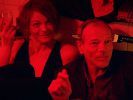Eye For Film >> Movies >> Portrait Of The Artist (2014) Film Review
Portrait Of The Artist
Reviewed by: Anne-Katrin Titze

Antoine Barraud's Portrait Of The Artist (Le Dos Rouge) was co-produced by the Centre Pompidou, where it had its première. The composition of this thorny, intangible and episodic cinematic dream is an arrangement of narrative clusters on art that can be funny or absurd or very confusing.
We follow the steps of filmmaker Bertrand, played by filmmaker Bertrand Bonello (who looks as though he perpetually just woke up from a nightmare), in search of the perfect depiction of the monstrous in an artwork to use as inspiration for his next movie. Bonello's own films are no strangers to the pursuit of the monster, be it the eternal smile inflicted upon a prostitute in his fin-de-siècle House Of Tolerance (L'Apollonide - Souvenirs De La Maison Close) or the unforgettable staging of the demise of Yves Saint Laurent's dog, haunting the fashion genius and the spectators of Bonello's film forever more. Ingrid Caven: Musique Et Voix from 2012, a most unusual concert film about the Fassbinder actress, is a good example of finding alluring monstrosity in sound.

Not by chance, Barraud's first short film was called Monstre.
The mystifying portrait in Le Dos Rouge is set in motion by the voiceover of what we are to believe is Bertrand's mother (Charlotte Rampling), talking about her small son's artistic preferences. "He loved Bosch and Bruegel, as children do," and once he discovered Klimt and Schiele and Cranach, it changed him, he developed Stendahl syndrome, the illness that strikes when you are overcome with the strongest emotion while regarding a work of art. In a museum, Rampling's incomparable voice concludes, "my son became a man." A linear narrative is not in sight and the individual encounters and musing weave an intriguing web of art perception.
What follow are visits to museum after museum in Bertrand's present, at least half of the film a guided tour of artworks with the guide at times more in focus than the painting in the distance. The search for the perfect inspiration commences with the statue of the Hermaphrodite (you can find out more about that transformation at this year's Rendez-Vous with French Cinema in Christophe Honoré's Métamorphoses).
The art historian, hired to accompany Bertrand to the museums, is called Célia Bhy and is played by both Jeanne Balibar and Géraldine Pailhas. The double, according to Freud, is one of the most frightening encounters one can have, which suggests a possible direction for the filmmaker's quest. He wants a woman monster, that's for sure. "The Virgin is a monster by definition," Balibar's version of Célia comments on Mary's powers, with a helping of blasphemy on the side.
The construction of a feather, cork, and a hatpin hanging on a wall changes entirely once you know the title of Joan Miró's Portrait of a Dancer. In front of a Francis Bacon triptych or a little Auguste Renoir painting the museum strollers conjure up Diane Arbus photographs in memories and words.
Besides the many visited museums, we encounter Pascal Greggory as actor Pascal, who during a preliminary meeting puts tiny squares of paper on his fingernails. In the next shot he has them on his knuckles. His monster begins with a claw. Barbe (Joana Preiss) is Bertrand's wife, an actress who wants to have horns. Nathalie Boutefeu plays Bertrand's tap-dancing sister Catherine. We only get to see her face and not her feet while she dances. Barbet Schroeder as a retired doctor angrily tells Bertrand off that he is not a dermatologist when his friend comes by with a problem.
All of this search for the monsters outside has made Bertrand develop a spreading red mark on his body, a map of the painted horrors, perhaps. The rash spreads in the form of a small hand and grows into the "red back" the original French title alludes to.
The fictional filmmaker's past shows itself during a Vertigo inspired scene, that has Isild Le Besco dressed in Kim Novak's grey suit. Her hair is down and she is being scolded by Alex Descas as Scottie, telling her "you should have put it up." During what looks like a post-screening Q&A for this dream within the film within the film, the discussion evolves around the women as victims, taught to give up and transform for the man's benefit.
When Bertrand meets a journalist (Nicolas Maury) for an interview in a café, he is not in the right mood to answer questions about topics such as his perspective on "contradiction as artistic value or as space." He cuts the young man off to reschedule for another time and to everyone's surprise it is indeed not the last time we and he encounter the flustered young man with the well-prepared questions.
An English speaking stranger sporting giant bug-like headphones Bertrand talks to about the ghostly eyes in the painting in front of them, also returns at a dinner party that connects many of the film's curious figures. The party itself could very well be remembered as a cabinet of bourgeois horrors, as Pascal Greggory, all Shakespearean fool, serenades in an improvised chant "I feel you," to whoever catches his glance.
Portrait Of The Artist (Le Dos Rouge) will be screening at the 20th Anniversary of Rendez-Vous with French Cinema in New York.
Reviewed on: 25 Feb 2015
















